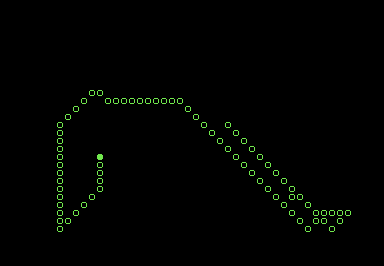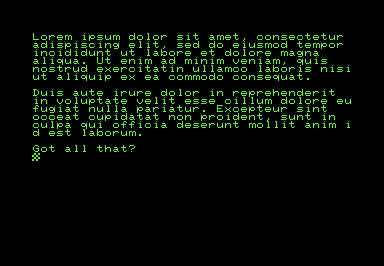CURSOR #1 – July 1978
“Yes, we purchase programs! We want original, interesting programs. We will try
to evaluate each program and get back to you within four weeks...We pay well, and of course we give credit
to each author.”
—Excerpted from Your Programs in CURSOR, Issue #1

COVER
Author: Uncredited
Original file name: COVER
PRG file: cover01.prg
The first program on the tape is called COVER. The cover page features an animation of the two PETSCII "ball" characters
(SHIFT-Q and SHIFT-W) moving diagonally around the screen and bouncing when they hit an edge. The animation is a bit
flickery because the program has to erase each ball before drawing it in its new location. A nice detail is that the program caches the character
underneath each moving ball, so that when a ball passes over any of the text around the edges of the screen, it can restore the text instead of
wiping it out. Pressing SPACE stops the animation and takes you to the
table of contents for the issue.
The table of contents shows a list of the files on the tape and could have been implemented as a menu where you'd choose a program and have it load
automatically. Instead, you are expected to break out of the program with STOP and then load your choice of file by hand.

BRICK
Author: Glen Fisher
Original file name: BRICK
PRG file: brick.prg
BRICK is a simple timing game in which you try to stop a moving block (the eponymous brick) before it reaches the right edge of the
screen. To get a high score, try to stop as close to the right edge as possible without hitting the "window" drawn on the right side. The gimmick is
that the block disappears partway across the screen—in a random location each time—so you must remember how fast the block was moving and
guess at the best time to stop it. The instructions say you must press the Y key to stop the brick, but you can actually press any key.
When you first run the program, you are greeted by
Cursor's standard title screen layout
which features a custom input routine using GET and substring manipulation to simulate a flashing cursor.

WANDER
Author: Glen Fisher
Original file name: WANDER
PRG file: wander.prg
This one's a fun little time waster that draws a snake that wanders randomly around the screen. Press SPACE to pause and unpause
the worm. While the snake is paused, you can press any other key to change the character that makes up its body. If your timing is really precise,
you can abuse this feature to
display a message but this is a really hard trick to pull off.
The snake will occasionally box itself in and get stuck but if you're patient, it will eventually manage to uncoil itself and resume wandering.

SHARK
Author: Glen Fisher
Original file name: SHARK
PRG file: shark.prg
SHARK is a turn-based game where you play as (SPOILER ALERT!) a shark. Avoid traps and eat as many swimmers as you can before
they can escape to the beach. The swimmers will try to avoid you as they head for the beach; divers will try to catch you. Move your shark
with the numeric keypad.
The game lets you configure the number of traps, swimmers, and divers for each playthrough. The recommended settings are 5 traps, 25 swimmers, and 1 or 2 divers. If there are a large number of entities on screen at once, refreshing the playfield each turn becomes uncomfortably slow.

PLOT
Author: Glen Fisher
Original file name: PLOT
PRG file: plot.prg
This program plots a mathematical function selected from a menu of functions. The user can define their own function to plot by modifying lines 800-999 of the original program.

TYPER
Author: Glen Fisher
Original file name: TYPER
PRG file: typer.prg
This is a simple "typewriter" program, where the user types characters which are then echoed to the screen. The typerwriter is a variant of
the custom input routine found on the
intro screen, where keypresses are captured with GET. There are several limitations to this
program: the INSERT key does not function, you cannot scroll past the bottom of the screen, and there is no way to save your
typewritten screens.
All of the credited programs on this tape were written by Glen Fisher—I suspect that he wrote the cover program as well.
